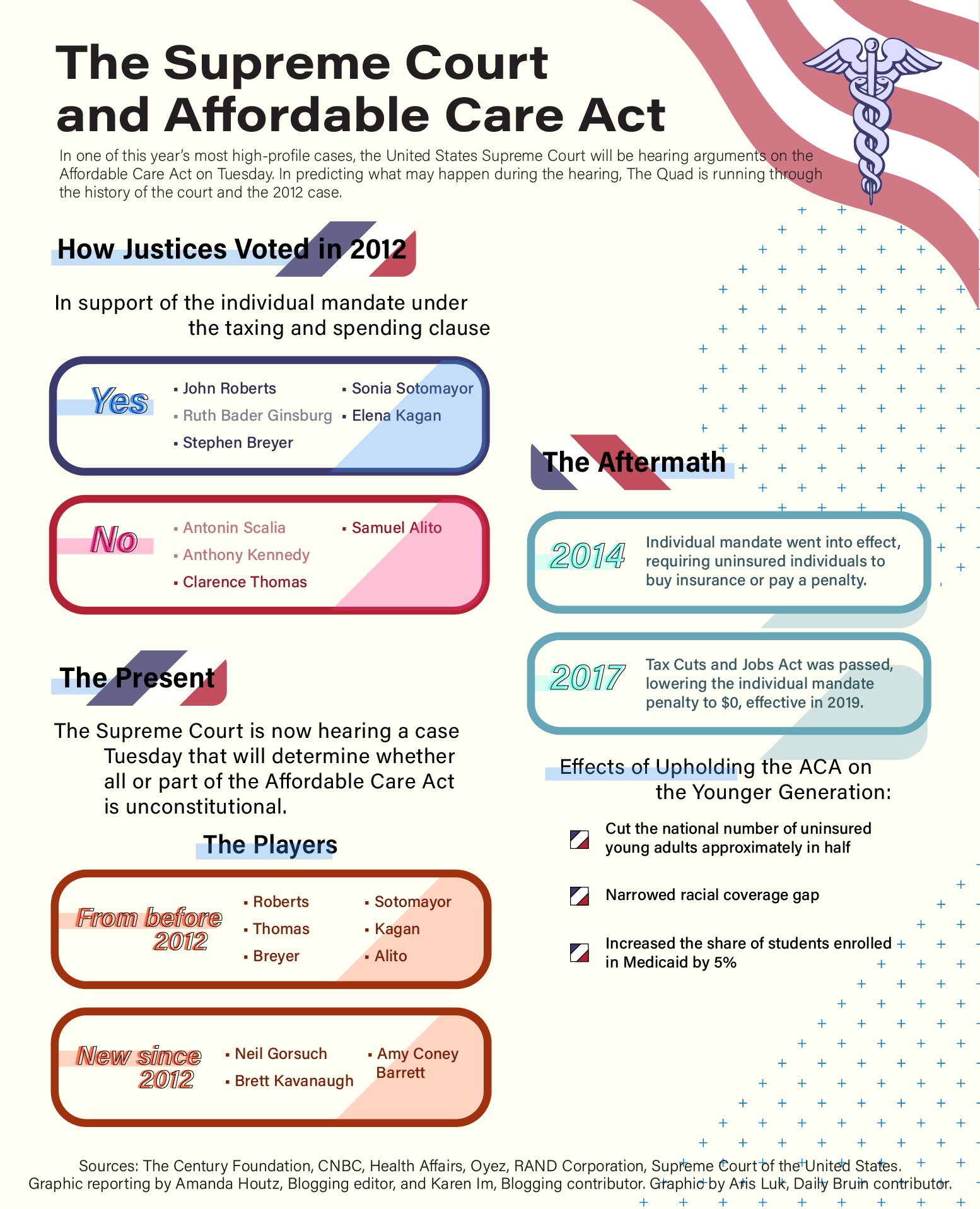The Quad: Exploring how the repeal of the Affordable Care Act would affect college students

This post was updated Nov. 15 at 6:22 p.m.
This post was updated Nov. 14 at 8:22 p.m.
Blink and you’ll miss it: the American people face yet another major change to how domestic policy in the United States operates. This time, it pertains to our health care.
In anticipation of the Affordable Care Act coming before the Supreme Court for the second time Nov. 10, The Quad is trying to predict what the fate of the act and the repercussions for students might be in this 6-3 conservative Court.
The ACA first came before the Court in 2012 in National Federation of Independent Business v. Sebelius. Stephen Gardbaum, a constitutional law professor at the UCLA School of Law, said this case centered on the challenge to the constitutionality of the individual mandate provision of the act, which required uninsured individuals to purchase health insurance or face a penalty.
The Court ruled in a 5-4 decision that the individual mandate was constitutional under Congress’ taxing power. It was when the tax was reduced to $0 through the Tax Cuts and Jobs Act of 2017 that questions over the mandate’s constitutionality were reintroduced, Gardbaum said.
But the bigger question on the table now is whether the entire ACA will fall if the individual mandate is determined to be unconstitutional.
“I would be very shocked, frankly, if they decided the so-called severability question in favor of striking down the whole act,” said Jonathan Varat, another professor at the UCLA School of Law.
While the future of the 10-year-old health care reform law remains shrouded in uncertainty, the outcome of the decision could yield notable implications for young adults – college students in particular.
Historically, younger populations have been the age group with the largest number of individuals without health insurance. After the implementation of key provisions of the ACA, this percentage decreased by nearly half, with the uninsured rate for 18-to-34 year-olds dwindling from 29% in 2010 to 14% in 2020.
These numbers may be explained by the various provisions under the ACA – one being the allowance of young individuals to remain on a parent’s health plan until the age of 26. During this financially vulnerable period of a student’s life, which often sits at the intersection of higher education costs and entry-level jobs – if they have a job at all – this provision provided security for young adults.
In addition to the dependent coverage provision, the ACA also resulted in an increase of 4% in employer insurance for students under the employer shared responsibility provisions, which incentivize certain employers to offer health coverage that is affordable and adequate to their full-time employees and full-time employees’ dependents.
To first-year electrical engineering student and Bruin Political Union social media director Ava Asmani, the ACA has established a means of providing health care to fellow Bruins in ways that many individuals could not access before.
“This is important because as humans, we should always have the option of going to a hospital or somewhere else in order to get medical help,” Asmani said.
Additionally, a growing portion of college students come from low-income families, who also tend to be disproportionately made up of people of color. As a result, accessibility is one of the most important facets of the ACA.
The ACA not only developed subsidies to improve the affordability of premiums for low and middle-income individuals, but also granted free coverage for the lowest-income populations through an extension of Medicare to adults without children living at or near the poverty line, a group that includes many college students.
According to different studies released by the Lookout Mountain Group and Century Foundation, the percentage of low-income Black and Hispanic students with medical coverage increased by around 16% respectively for each group from 2010 to 2018.
In the case of a repeal of the law, students who are left uninsured would likely have to buy college health insurance, which not all schools offer.
Asmani said for many students at UCLA, affordable medical coverage has been around under the ACA, but now that option may be on the chopping block with new conservative federal leadership.
Younger populations face an extra health risk with the reopening of universities and colleges as the likelihood of exposure to COVID-19 increases – a fact that elicits greater concern about the future of how these populations will access health coverage.
On the other end, the ACA keeps health insurance affordable for families earning less than 400% of the poverty line by raising taxes for wealthy households — an idea that has received pushback from many.
According to a Tax Policy Center analysis, repealing the ACA would result in lower taxes for individuals in the top 1% of the income distribution. There would also be a subsequent increase in the taxes of households in the bottom 60% of the income distribution if the ACA’s tax credits are taken away.
Varat said the Supreme Court will likely be affected by the election’s outcome, which, as we found out Nov. 7, resulted in a Democratic victory.
“I think there’s a limit to how far away from the mood of the American people the Supreme Court is willing to go by themselves,” Varat said.
Whether this theory will play a role in the ACA case remains to be seen, and of course will be open for interpretation.
It is important to keep in mind that the United States government was constructed to purposefully prevent any one branch of government from wielding too much power. So, what happens in the Court is merely a part of shaping the direction of United States laws and policies.




